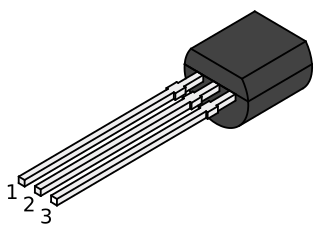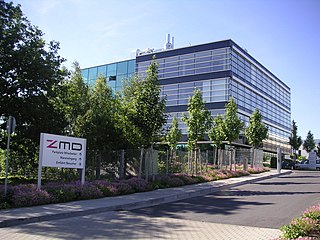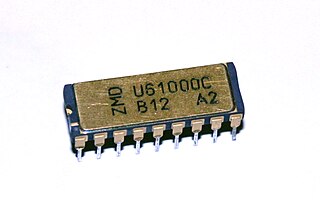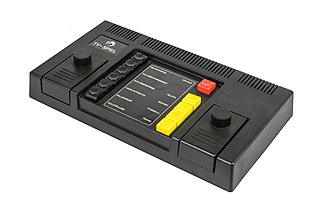
VEB Kombinat Robotron was the largest East German electronics manufacturer. It was headquartered in Dresden and employed 68,000 people in 1989. Its products included personal computers, SM EVM minicomputers, the ESER mainframe computers, various computer peripherals as well as microcomputers, radios, television sets and other items including cookie press Kleingebäckpresse Typ 102.
Pro Electron or EECA is the European type designation and registration system for active components.

The Zilog Z8 is a microcontroller architecture, originally introduced in 1979, which today also includes the Z8 Encore!, eZ8 Encore!, eZ8 Encore! XP, and eZ8 Encore! MC families.

The TO-92 is a widely used style of semiconductor package mainly used for transistors. The case is often made of epoxy or plastic, and offers compact size at a very low cost.

Zentrum Mikroelektronik Dresden (ZMD) was regarded as the heart of East Germany's microelectronics research in the 1980s as well as its most advanced integrated circuit manufacturer. Together with TU Dresden and VEB Spurenmetalle Freiberg, ZMD formed the foundation for Silicon Saxony, a cluster of microelectronics companies that came to include new fabs by Siemens and AMD.

The U880 is an 8-bit microprocessor that was manufactured by VEB Mikroelektronik "Karl Marx" Erfurt in the German Democratic Republic. Production of the U880 started in 1980 at VEB Funkwerk Erfurt. The U880 is an unlicensed clone of the Zilog Z80 microprocessor, also supporting illegal opcodes and bugs, except for very minor differences like not setting the CY flag for the OUTI command.

The X-FAB Silicon Foundries is a group of semiconductor foundries. The group specializes in the fabrication of analog and mixed-signal integrated circuits for fabless semiconductor companies, as well as MEMS and solutions for high voltage applications. The holding company named "X-FAB Silicon Foundries SE" is based in Tessenderlo, Belgium while its headquarters is located in Erfurt, Germany.

The Ferdinand-Braun-Institut, Leibniz-Institut für Höchstfrequenztechnik (FBH) is a research institute, which is a member of the Gottfried Wilhelm Leibniz Scientific Community. The institute is located in Berlin at the Wissenschafts- und Wirtschaftsstandort Adlershof (WISTA), its research activity is applied science in the fields of III-V electronics, photonics, integrated quantum technology and III-V technology

The MRB Z 1013 was an East German single-board computer produced by VEB Robotron Riesa, which was primarily intended for private use and educational institutions. It was powered by a U880 processor and sold together with a membrane keyboard. Initially, the kit was equipped with 16 kilobytes of DRAM, which was later replaced by a 64 KB version.

The U80701 is a 32-bit microprocessor developed from 1986-1990 in the German Democratic Republic. It was manufactured by VEB Mikroelektronik "Karl Marx" Erfurt (MME) in NMOS technology and is encased in a ceramic quad flat package.
Leibniz-Institut für innovative Mikroelektronik is a German research institute located in Frankfurt (Oder), Brandenburg, Germany. The IHP was founded in 1983 as Institut für Halbleiterphysik, and is today part of the Gottfried Wilhelm Leibniz Scientific Community. The institute has four departments: System Design, Circuit Design, Technology and Materials Research.

The Robotron KC 87, fully known as Kleincomputer robotron KC 87, was an 8-bit microcomputer released in 1987 and produced in East Germany by VEB Robotron-Meßelektronik "Otto Schön" Dresden, part of Kombinat Robotron.

The A 5120 was an office computer produced by VEB Robotron in Karl-Marx-Stadt, East Germany starting in 1982. The system featured an 8-bit microprocessor, the U880. It was built for office work and had minimal graphics and sound capabilities. The price was between 27,000 and 40,000 East German marks depending on equipment.

East Germany was one of the leading computer producers in the Eastern Bloc as purchases of higher technologies from the West were under various embargoes. A program of illegal purchases, copying and reverse engineering of Western examples was established, after which GDR sold these computers to COMECON countries. Under the rule of Erich Honecker, electronics, microelectronics and data processing industries grew at average 11.4% in the 1970s and 12.9% during the 1980s.

The Bildschirmspiel 01 is the only game console that was developed and manufactured in the German Democratic Republic (GDR). It is based on the integrated circuit AY-3-8500 by General Instrument. The gameplay, controls and audiovisual presentation of the four individually selectable games are similar to Pong. The BSS 01 was designed and produced by VEB Halbleiterwerk Frankfurt an der Oder (HFO). Its sales were started in 1979 under the RFT brand at a price of 550 East German marks. Due to a lack of profitability, production was discontinued after just two years. A successor device with more game options and additional colored image output did not pass the prototype stage.
The electronics industry in the Socialist Republic of Romania was characterized by stronger ties to Western Europe when compared to other countries in the Eastern Bloc due to the drive of the Romanian leadership towards greater autonomy from the Soviet Union.

The educational computer LC80 was a single-board computer manufactured in the German Democratic Republic (GDR) and intended for teaching purposes. It was the first computer that retail customers could buy in the GDR.

VEB Halbleiterwerk Frankfurt (Oder) (abbreviated HFO or HWF) was the largest manufacturer of semiconductor devices in the German Democratic Republic. In 1989, HFO produced 110 million integrated circuits (70% of all integrated circuits produced in the GDR in that year), 9.7 million transistors, and 150 million transistor chips. Despite this, HFO did not rise to prominence like Zentrum Mikroelektronik Dresden (of megabit chip fame) or VEB Mikroelektronik "Karl Marx" Erfurt (known for its microprocessors). Also unlike Zentrum Mikroelektronik Dresden and VEB Mikroelektronik "Karl Marx" Erfurt, HFO did not survive long after German Reunification.
The UC compander system is a noise reduction system for vinyl records, aiming at highest playback compatibility even without corresponding UC expander.































